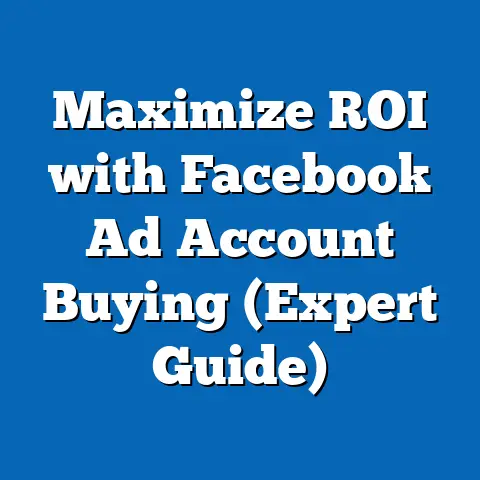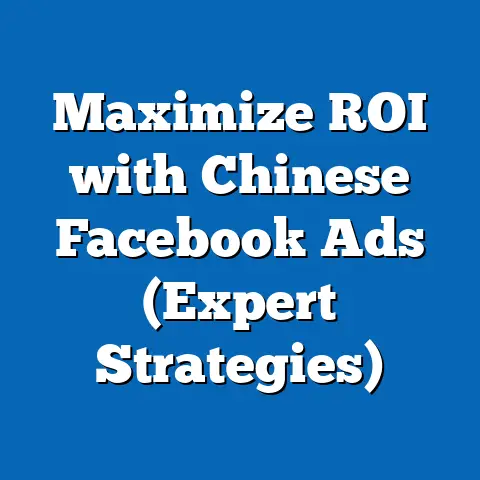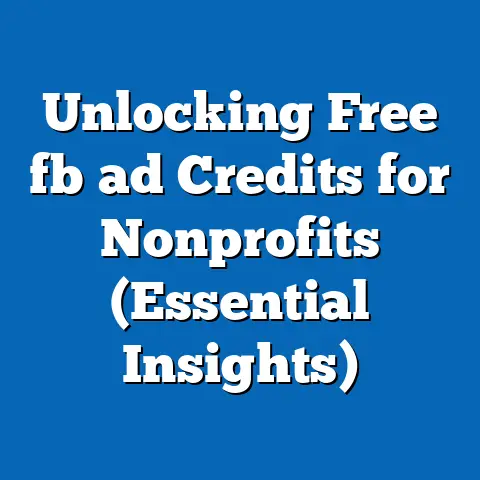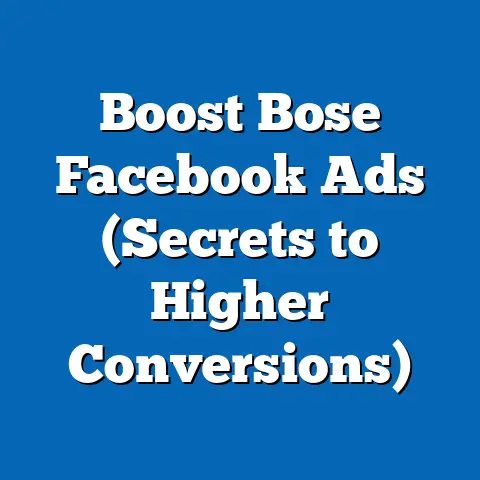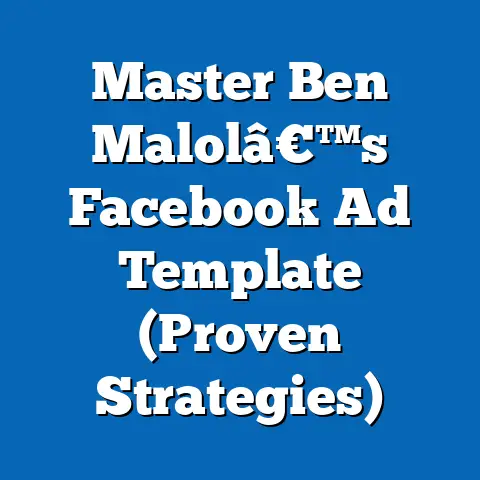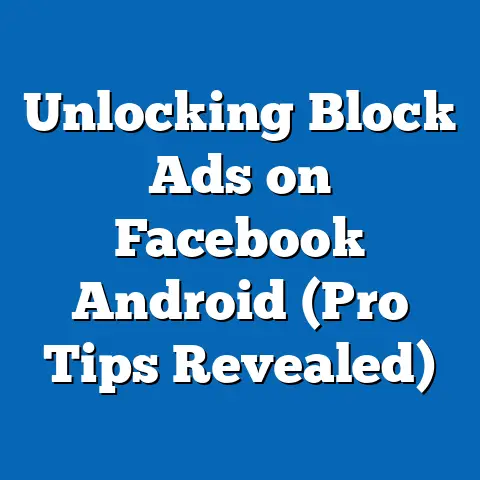Master Facebook Ads: Unlocking Success (Expert Strategies)
Are you tired of throwing money into Facebook ads and seeing little to no return? Do you feel like you’re constantly battling the ever-changing algorithms, struggling to reach your target audience amidst a sea of competing voices? You’re not alone. I’ve been there, staring at confusing metrics, wondering where all the budget went, and feeling the pressure to deliver results. It’s a frustrating experience, especially when you know the potential that Facebook advertising holds.
In today’s digital landscape, standing out is harder than ever. Businesses are bombarded with advice, tools, and “expert” opinions, making it difficult to navigate the complexities of online marketing. But what if I told you that mastering Facebook Ads isn’t a pipe dream? What if you could unlock the platform’s power to reach your ideal customers, drive conversions, and achieve your business goals?
Understanding the Facebook Ads Ecosystem
Facebook, now Meta, isn’t just a social media platform; it’s an advertising powerhouse. With billions of active users, it offers unparalleled reach and targeting capabilities, making it an essential tool for businesses of all sizes. According to Statista, Facebook’s ad revenue in 2023 reached over $130 billion, demonstrating the platform’s continued dominance in the digital advertising space. But to truly harness its power, you need to understand the different components of the Facebook Ads ecosystem.
Ad Formats: Choosing the Right Medium
Facebook offers a variety of ad formats, each designed to capture attention and drive specific actions. Here’s a breakdown of some of the most popular options:
- Image Ads: Simple, yet effective, image ads are perfect for showcasing your product or service with a visually appealing image and concise copy. I’ve found that high-quality images that clearly demonstrate the product’s benefits tend to perform best.
- Video Ads: Video ads are incredibly engaging and can be used to tell a story, demonstrate a product, or share customer testimonials. I’ve seen video ads generate significantly higher engagement rates compared to static images, especially when they’re optimized for mobile viewing.
- Carousel Ads: Carousel ads allow you to showcase multiple images or videos in a single ad unit, making them ideal for highlighting different features of a product or telling a more complex story. I often use carousel ads to showcase different angles of a product or to highlight different products within a collection.
- Collection Ads: Collection ads are designed for e-commerce businesses and allow you to showcase a catalog of products in a visually appealing format. These ads are great for driving traffic directly to your online store.
- Lead Ads: Lead ads are designed to capture leads directly within the Facebook platform, making it easy for users to submit their information without leaving the app. I’ve found lead ads to be particularly effective for generating leads for services like consultations or free trials.
Choosing the right ad format depends on your specific goals and target audience. Consider what type of content will resonate most with your audience and experiment with different formats to see what performs best.
The Power of Facebook Ads Manager
The Facebook Ads Manager is your command center for creating, managing, and analyzing your Facebook ad campaigns. It’s a powerful tool, but it can also be overwhelming if you’re not familiar with its features. Understanding the Ads Manager is crucial for effective campaign management.
- Campaign Level: This is where you define your overall advertising objective (e.g., awareness, traffic, conversions).
- Ad Set Level: This is where you define your target audience, budget, and bidding strategy.
- Ad Level: This is where you create your individual ads, including the ad copy, visuals, and call-to-action.
I remember when I first started using the Ads Manager, I was completely lost. It took time and experimentation to understand how each level worked and how to optimize my campaigns for the best results. But once you get the hang of it, the Ads Manager becomes an indispensable tool for driving success with Facebook advertising.
Takeaway: Understanding the Facebook Ads ecosystem, including the different ad formats and the features of the Facebook Ads Manager, is essential for creating effective campaigns. Experiment with different ad formats and take the time to learn the ins and outs of the Ads Manager.
Defining Your Target Audience
Targeting is where Facebook advertising truly shines. It’s not just about reaching a large number of people; it’s about reaching the right people – those who are most likely to be interested in your product or service. A well-defined target audience can significantly improve your ad performance and reduce wasted ad spend. I’ve seen campaigns go from mediocre to outstanding simply by refining the audience targeting.
Creating Buyer Personas: Understanding Your Ideal Customer
Before you even start creating your ads, you need to understand who you’re trying to reach. Creating buyer personas is a powerful way to visualize your ideal customer and understand their needs, motivations, and pain points.
- Demographics: Age, gender, location, education, income, job title.
- Interests: Hobbies, passions, activities, favorite brands.
- Behaviors: Online habits, purchase history, website visits, Facebook page likes.
- Pain Points: Challenges, frustrations, problems they’re trying to solve.
- Goals: Aspirations, desires, what they’re trying to achieve.
I like to give my buyer personas names and even find stock photos that represent them. This helps me to stay focused on their needs when crafting my ad copy and creative.
Leveraging Facebook Insights: Data-Driven Targeting
Facebook Insights provides valuable data about your audience, including demographics, interests, and behaviors. You can use this data to refine your targeting and ensure that you’re reaching the right people.
- Page Insights: If you have a Facebook page, you can access Page Insights to learn more about your followers.
- Audience Insights: Audience Insights allows you to explore the interests and demographics of people on Facebook, even if they’re not your followers.
I often use Audience Insights to discover new interests and behaviors that I hadn’t considered before. This can lead to surprisingly effective targeting strategies.
Custom Audiences: Reaching Existing Customers and Lookalikes
Custom Audiences allow you to target specific groups of people based on their existing relationship with your business. This can include:
- Website Visitors: Target people who have visited your website.
- Email List: Upload your email list to target your existing customers.
- App Users: Target people who have used your mobile app.
- Facebook Engagement: Target people who have engaged with your Facebook page or ads.
One of the most powerful features of Custom Audiences is the ability to create Lookalike Audiences. Lookalike Audiences allow you to target people who are similar to your existing customers, based on their demographics, interests, and behaviors. I’ve found Lookalike Audiences to be incredibly effective for expanding my reach and finding new customers.
A/B Testing: Finding the Winning Combination
Don’t be afraid to experiment with different audience segments to see what performs best. A/B testing different targeting options can help you identify the most responsive groups and optimize your campaigns for maximum ROI.
- Test different demographics: Try targeting different age groups, genders, or locations.
- Test different interests: Experiment with different interests and behaviors.
- Test different Lookalike Audiences: Create multiple Lookalike Audiences based on different sources (e.g., website visitors, email list) and see which performs best.
Takeaway: Defining your target audience is crucial for Facebook Ads success. Create buyer personas, leverage Facebook Insights, and utilize Custom Audiences to reach the right people. Don’t forget to A/B test different audience segments to optimize your targeting.
Crafting Compelling Ad Copy and Creative
Even with perfect targeting, your ads won’t perform well if the ad copy and creative aren’t compelling. You need to grab attention, convey your message clearly, and inspire action. This is where the art of storytelling and persuasive writing comes into play. I’ve seen ads with mediocre targeting perform exceptionally well simply because the ad copy and creative were outstanding.
Emotional Triggers: Connecting with Your Audience
People are emotional creatures, and your ad copy should tap into those emotions. Consider what motivates your target audience and use emotional triggers to resonate with them.
- Storytelling: Tell a story that connects with your audience and demonstrates the benefits of your product or service.
- Urgency: Create a sense of urgency to encourage immediate action.
- Relatability: Show that you understand your audience’s pain points and challenges.
- Social Proof: Use testimonials, reviews, and case studies to build trust and credibility.
I often use storytelling in my ad copy to create a connection with my audience. Sharing a relatable story about how my product or service has helped someone overcome a challenge can be incredibly effective.
Eye-Catching Visuals: Stopping the Scroll
In a crowded news feed, your visuals need to stand out. Use high-quality images and videos that are visually appealing and relevant to your message.
- Use bright colors: Bright colors can help your ads stand out in the news feed.
- Show faces: People are drawn to faces, so consider using images that feature smiling people.
- Use video: Video ads are incredibly engaging and can be used to tell a story or demonstrate a product.
- Keep it simple: Don’t overcrowd your visuals with too much text or graphics.
I always make sure my visuals are optimized for mobile viewing, as the majority of Facebook users access the platform on their smartphones.
Strong Calls-to-Action: Guiding the User
Your call-to-action (CTA) is the final nudge that encourages users to take the desired action. Use clear and concise CTAs that tell users exactly what you want them to do.
- Shop Now: For e-commerce businesses.
- Learn More: For informative content.
- Sign Up: For email lists or subscriptions.
- Contact Us: For service-based businesses.
- Download Now: For ebooks or software.
I always test different CTAs to see which performs best. Sometimes, a simple change in wording can significantly impact conversion rates.
Brand Voice: Maintaining Consistency
Your ad copy and creative should be consistent with your brand voice and messaging. This helps to build brand recognition and trust.
- Use your brand colors and fonts.
- Maintain a consistent tone of voice.
- Reflect your brand values.
Takeaway: Crafting compelling ad copy and creative is essential for grabbing attention and driving action. Use emotional triggers, eye-catching visuals, strong calls-to-action, and maintain a consistent brand voice.
Budgeting and Bidding Strategies
Setting the right budget and choosing the right bidding strategy are crucial for maximizing your return on ad spend. You need to find the sweet spot where you’re spending enough to reach your target audience but not overspending and wasting money. I’ve seen businesses waste thousands of dollars by simply not understanding the different budgeting and bidding options.
Daily vs. Lifetime Budgets: Choosing the Right Approach
Facebook offers two main budgeting options:
- Daily Budget: Sets a daily average amount you’re willing to spend on your ads.
- Lifetime Budget: Sets a total amount you’re willing to spend over the entire duration of your campaign.
I typically recommend using a daily budget for ongoing campaigns, as it allows for more flexibility and control. Lifetime budgets are better suited for campaigns with a specific end date.
Automatic vs. Manual Bidding: Finding the Optimal Balance
Facebook offers two main bidding strategies:
- Automatic Bidding: Facebook automatically sets your bids to get the most results for your budget.
- Manual Bidding: You manually set your bids for each ad set.
Automatic bidding is a good option for beginners, as it takes the guesswork out of bidding. However, manual bidding allows for more control and can be more effective for experienced advertisers.
- Cost Per Click (CPC) Bidding: You pay each time someone clicks on your ad.
- Cost Per Impression (CPM) Bidding: You pay for every 1,000 impressions your ad receives.
- Cost Per Acquisition (CPA) Bidding: You pay each time someone takes a specific action, such as making a purchase or signing up for a newsletter.
Analyzing Return on Ad Spend (ROAS): Measuring Success
Return on Ad Spend (ROAS) is a key metric for measuring the success of your Facebook ad campaigns. It tells you how much revenue you’re generating for every dollar you spend on advertising.
- ROAS = (Revenue Generated from Ads) / (Ad Spend)
A ROAS of 2 means you’re generating $2 in revenue for every $1 you spend on advertising.
Understanding Cost-Per-Click (CPC): Optimizing for Efficiency
Cost-Per-Click (CPC) is another important metric to track. It tells you how much you’re paying each time someone clicks on your ad.
- CPC = (Ad Spend) / (Number of Clicks)
A lower CPC generally indicates that your ads are more relevant to your target audience.
Takeaway: Budgeting and bidding strategies are crucial for maximizing your return on ad spend. Choose the right budgeting option, experiment with different bidding strategies, and track your ROAS and CPC to optimize your campaigns.
Analyzing and Optimizing Campaign Performance
Running a Facebook ad campaign isn’t a “set it and forget it” process. You need to constantly monitor your campaign performance and make adjustments as needed. Analyzing your data and optimizing your campaigns is crucial for achieving your advertising goals. I’ve seen campaigns that started off poorly turn into massive successes simply by consistently analyzing the data and making adjustments.
Key Performance Indicators (KPIs): Tracking What Matters
Key Performance Indicators (KPIs) are the metrics that you use to track the success of your Facebook ad campaigns. Some of the most important KPIs include:
- Click-Through Rate (CTR): The percentage of people who see your ad and click on it.
- Conversion Rate: The percentage of people who click on your ad and take the desired action (e.g., make a purchase, sign up for a newsletter).
- Cost Per Acquisition (CPA): The cost of acquiring a new customer or lead.
- Return on Ad Spend (ROAS): The revenue generated for every dollar spent on advertising.
- Impressions: The number of times your ad is displayed.
- Reach: The number of unique people who see your ad.
- Frequency: The average number of times each person sees your ad.
Regular Performance Analysis: Identifying Trends and Opportunities
It’s important to regularly analyze your campaign performance to identify trends and opportunities. Look for patterns in your data and see what’s working and what’s not.
- Check your data daily: Monitor your KPIs on a daily basis to identify any sudden changes or trends.
- Analyze your data weekly: Take a deeper dive into your data on a weekly basis to identify longer-term trends.
- Compare your data to previous periods: Compare your current data to your data from previous periods to see how your campaigns are performing over time.
Actionable Tips for Optimization: Making Data-Driven Decisions
Based on your performance analysis, you can make adjustments to your campaigns to improve their performance.
- Adjust your targeting: If your ads aren’t reaching the right people, adjust your targeting to be more specific.
- Modify your ad creative: If your ads aren’t generating enough clicks or conversions, try modifying your ad copy and visuals.
- Tweak your budgets: If your campaigns are performing well, consider increasing your budget to reach more people. If they’re not performing well, consider decreasing your budget or pausing the campaign.
- A/B test different variations: Continuously A/B test different ad copy, visuals, and targeting options to find the winning combinations.
- Refine your bidding strategy: Experiment with different bidding strategies to see which performs best for your specific goals.
Takeaway: Analyzing and optimizing campaign performance is crucial for Facebook Ads success. Track your KPIs, regularly analyze your data, and make data-driven decisions to improve your campaign performance.
Conclusion
Mastering Facebook Ads isn’t a sprint; it’s a marathon. It requires dedication, persistence, and a willingness to learn and adapt. The strategies I’ve shared in this article are a starting point, but the real key to success lies in your ability to continuously test, analyze, and optimize your campaigns.
Don’t be discouraged if you don’t see results immediately. It takes time to find the right targeting, create compelling ad copy and creative, and optimize your bidding strategy. But with the right mindset and a data-driven approach, you can unlock the power of Facebook Ads and achieve your business goals.
Now it’s your turn to take action. Implement the strategies I’ve shared, track your results, and continuously optimize your campaigns. The journey to Facebook Ads success may be challenging, but the rewards are well worth the effort.
So, go out there and start experimenting! You have the knowledge and the tools to succeed. I’m confident that with the right strategies and a little bit of perseverance, you can unlock the full potential of Facebook Ads and achieve your advertising goals. Good luck!

